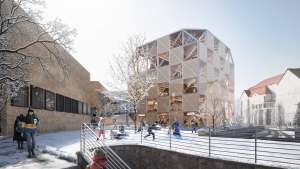Rammed earth constructions are not a novelty, on the contrary, some sections of the Great Wall of China were made using this technique. Relegated and replaced by modern methods of construction, the mud walls are currently re-emerging as an economic, sustainable solution, with low environmental impact.
Even Joelle Eyeson, a young African entrepreneur, is betting that it may be the answer to the housing deficit in her region.
This is a rudimentary construction system in which earth is compressed into wooden boxes. The clay is horizontally placed in layers of 15 cm in height, and compacted with manual or pneumatic tools, to achieve its ideal density creating a resistant and durable structure.
In 2016, she co-founded Hive Earth, a company specialising in rammed earth construction, based in Ghana. Her proposal is to build accessible and ecologically sound housing through this system, using materials of local origin and available in abundance throughout West Africa.
The walls are made with a combination of earth, sand, clay, and 5% cement, however, according to Joelle, if the client wants to be 100% ecological, cement can be replaced by lime. The construction process of Hive Earth is quite simple. The materials are selected and placed in a mixer to form a wet mass.
Once the mixture is ready, it is placed in molds and distributed so that it is compressed to half the original height. After that, the molds are removed to dry and cure.
The walls built by Hive Earth have attracted attention due to their aesthetics. The combination of layers with different earth mixtures result in drawings with waves, natural textures, and beautiful earthy tones. No rammed earth wall is equal to the next.
"Many of the colors you see on the walls are natural colors of the earth. In Ghana, we have so many different variations of earth that we can get light beige, gray, red or even black. Sometimes we add iron oxide pigments to create brighter colors if the client asks for it," says Joelle.
The housing deficit in Ghana currently stands at 1.7 million homes, and that number continues to grow. Due to the low cost of building with earth, Hive Earth manages to build a one-bedroom house for only $5,000 USD.
According to the company, this can solve the housing crisis not only in Ghana but also throughout the African continent.
In addition to its low cost, another benefit of building with earth is that it can cool interior spaces, decreasing the use of air conditioning systems. Its maintenance is also low and there is no need to paint the walls. The walls are sound and termite-proof, as well as free of chemicals and toxins that may be present in cement.
Hive Earth uses only 5% cement in its formula to give alloy, but when it is viable it is replaced by lime. The intention to use the minimum cement possible goes beyond the cost. Due to the excess of heat and humidity in Ghana, closed spaces with too much cement become unhealthy if they do not have adequate ventilation.
Hive Earth has also started new ventures and intends to produce residential decoration and finishing solutions. They also intend to hold workshops in universities to teach young people and future architects how to design with land, in addition to continuing to employ men and women, especially in rural areas, to reduce unemployment among young people.









